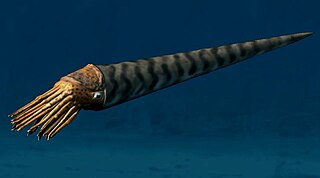
Orthoceratidae is an extinct family of actively mobile carnivorous cephalopods, subclass Nautiloidea, that lived in what would be North America, Europe, Asia, Africa, and Australia from the Ordovician through Triassic from 490—203.7 mya, existing for approximately 286.4 million years.
The Ellesmerocerida is an order of primitive cephalopods belonging to the subclass Nautiloidea with a widespread distribution that lived during the Late Cambrian and Ordovician.
Baltoceras is a member of the Ellesmerocerida, included in the family, Baltoceratidae. The shell of Baltoceras is slender with a subcircular cross section, straight transverse sutures, and a large siphuncle in contact with the venter. Septal necks are short but not vestigial; connecting rings are thick; endosiphonal organic deposits are unknown.
The Actinocerida comprise an order of generally straight, medium to large cephalopods that lived during the early and middle Paleozoic, distinguished by a siphuncle composed of expanded segments that extend into the adjacent chambers, in which deposits formed within contain a system of radial canals and a narrow space along the inner side of the connecting ring known as a paraspatium. Septal necks are generally short and cyrtochoanitic, some being recumbent, some hook shaped. Most grew to lengths of about 60 to 90 cm but some, like the Huroniidae of the Silurian grew significantly larger.
The Ellesmeroceratidae constitute a family within the cephalopod order Ellesmerocerida. They lived from the Upper Cambrian to the Lower Ordovician. They are characterized by straight and endogastric shells, often laterally compressed, so the dorso-ventral dimension is slightly greater than the lateral, with close spaced sutures having shallow lateral lobes and a generally large tubular ventro-marginal siphuncle with concave segments and irregularly spaced diaphragms. Connecting rings are thick and layered, externally straight but thickening inwardly with the maximum near the middle of the segment so as to leave concave depressions on internal siphuncle molds. Septal necks are typically orthochoanitic but vary in length from almost absent (achoanitic) to reaching halfway to the previous septum (hemichoanitic) and may even slope inwardly (loxochoanitic).
Cyptendoceras is an extinct nautiloid cephalopod included in the family Ellesmeroceratidae that lived in what would be North and South America during the latter part of the Early Ordovician from about 475 - 472 mya, existing for approximately 3 million years.
Cyrtobaltoceras is an extinct cephalopod genus known from the upper Lower Ordovician Fort Cassin Formation at Valcour, N.Y. that is included in the Nautiloid family Baltoceratidae
Endorioceras is an extinct genus of actively mobile carnivorous cephalopod of the family Baltoceratidae that lived in what would be North America during the Ordovician from 490–479 mya, existing for approximately 11 million years.
Rhabdiferoceras is an extinct genus of orthocerids belonging to the Baltoceratidae that lived in what would be North America during the Cassinian Stage at the end of the Early Ordovician, existing for approximately two million years from about 474 -472 mya.
Microbaltoceras is an extinct genus of the cephalopod family Baltoceratidae that lived in what would be North America during the Early Ordovician. It was named by Rousseau Flower (1964) and assigned by him to the Baltoceratidae. The type species is Microbaltoceras minore which was found in the Threadgill Member of the Tanyard Formation in Gillespie County, Texas, USA.
Tajaroceras is an extinct slender cephalopod from the uppermost Lower Ordovician of western North America, belonging to the Orthocerid family Troedssonellidae.

Troedssonellidae is a family of orthoceroid cephalopods from the Ordovician, derived from rod-bearing Baltoceratidae, that have a continuous lining within the siphuncle that resembles very thin and slender endocones. Shells are generally slender and orthoconic. The siphuncle is central or subcentral, composed of straight or slightly expanded segments. Septal necks generally short and connecting rings are thin. Thin cameral deposits are known, which along with the position of the siphuncle and thin connecting rings distinguishes them from the endocerids in which they have been included.
Rangeroceras is an extinct nautiloid cephalopod genus that lived in what is now western North America during the latter part of the Early Ordovician.
Veneficoceras is a genus of the rod-bearing Baltoceratidae, an extinct cephalopod family with characteristics of the orthoceratoid Dissidocerida, found in Cassinianage, Lower Ordovician, limestone in western Utah.
Intejocerida is the name given to a group of generally straight shelled nautiloid cephalopods originally found in Lower and Middle Ordovician sediments in the Angara River basin in Russia; defined in the Treatise as an order, and combined there with the Endocerida in the Endoceratoidea.
Cartersoceras is a genus of nautiloid cephalopods placed in the Orthocerid family Baltoceratidae, established by Rousseau Flower (1964), for species formally included in part in Murrayoceras, and in part in "Sacotoceras". This group is typical of Murrayoceras in all features except that the siphuncle segments are convex in outline. It is known from the Middle Ordovician of the eastern United States.
Murrayoceras is a nautilid cephalopod included in the orthocerid family Baltoceratidae, widespread in the Middle Ordovician of North America, characterized by a depressed orthoconic shell with a subtriangular cross section and flattened venter and a proportionally large verntral siphuncle, 0.15 to 0.3 the dorso-ventral shell diameter. Septa are close spaced with sutures forming broad lobes on the upper flanks and ventral surface.
Ellesmeroceras is the type genus for the Ellesmeroceratidae, a family of primitive nautiloid cephalopods, that is characterized by its small, generally compressed, gradually expanded, orthoconic shell, found in Lower Ordovician marine sediments. The septa are close spaced and the siphuncle is ventral, about 0.2 the diameter of the shell. Septal necks are typically orthochoanitic but may slant inwardly (loxochoanitic) or reach halfway to the previous septum (hemichoanitic). Connecting rings are thick. As common for the Ellesmerocerida, Ellesmeroceras has diaphragms within the siphuncle tube.
Apocrinoceratidae constitutes a family of Middle Ordovician nautiloid cephalopods characterized by straight or slightly curved, transversely ribbed shells having siphuncles composed of expanded segments, short recurved septal necks, and thick connecting rings. Derivation is from the Protocycloceratidae, a family of ellesmerocerids, which differ in having straight or concave siphuncle segments, but are otherwise similar in form.



